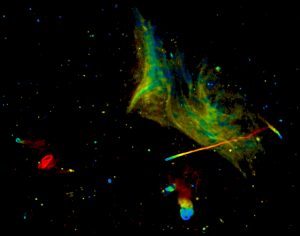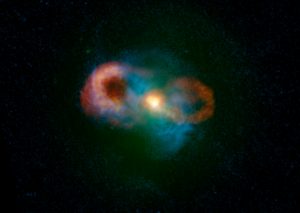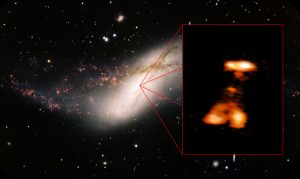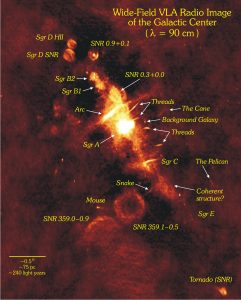Abell 2256, in a “true color” radio image made with the VLA


VLA Finds Unexpected “Storm” at Galaxy’s Core
In this composite image of the Teacup Galaxy, the green colors show the starlight, the blue colors show the gas and the red/yellow colors show the radio emission. The bright yellow blobs in the center of the image show where the radio “jets,” launched by the black hole, are driving into the gas and accelerating it to 1,000 km/s (200,000 miles per hour). The giant bubbles also are being inflated by the central black hole. This demonstrates that the central black hole is having a catastrophic effect on its home galaxy.

The supermassive black hole at the center of the Milky Way.
New evidence has been uncovered for the presence of a faint jet of high-energy particles blasting out of the Milky Way’s relatively quiet supermassive black hole known as Sagittarius A* (Sgr A*). This image of Sgr A* and the region around it contains some of the data used in the study, with X-rays from Chandra (purple) and radio emission from the Very Large Array (blue). Jets of high-energy particles are found throughout the Universe on large and small scales. The likely discovery of a jet from Sgr A* helps astronomers learn more about the giant black hole, including how it is spinning.

The supermassive black hole at the center of the Milky Way.
New evidence has been uncovered for the presence of a jet of high-energy particles blasting out of the Milky Way’s supermassive black hole known as Sagittarius A* (Sgr A*). This image of Sgr A* and the region around it contains radio emission data from the Very Large Array. Jets of high-energy particles are found throughout the Universe on large and small scales. The likely discovery of a jet from Sgr A* helps astronomers learn more about the giant black hole, including how it is spinning.

Outburst in NGC 660
Astronomers using the National Science Foundation’s (NSF) 305-meter William E. Gordon Telescope at Arecibo discovered an outburst in NGC 660, a spiral galaxy 44 million light-years distant in the constellation Pisces. The outburst, thought to be from a powerful belch by a gorging black hole at the galaxy’s center, was ten times brighter than the largest supernova, or exploding star.

Labeled Map of Our Galaxy’s Center
The diagonal line of bright objects in this image of the heart of our Milky Way Galaxy are all powerful sources of radio waves. The bright center is the home of the supermassive black hole, Sagittarius A*. The dense, bright circles are the nurseries of new, hot stars and the bubbles are the graveyards of exploded, massive stars. The thread-like shapes are not yet understood, but probably trace powerful magnetic field lines. This giant image was assembled from observations made by the Very Large Array (VLA).





